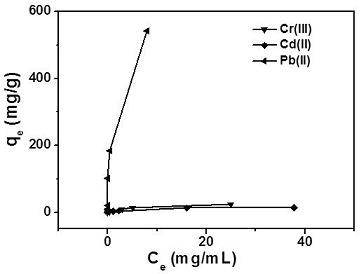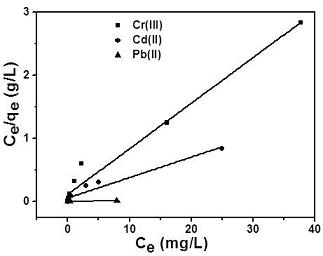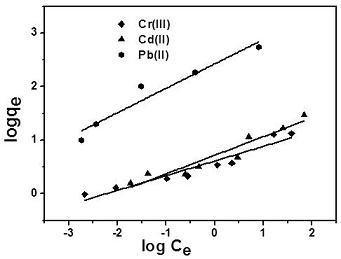A Simultaneous Rapid Adsorption of Heavy Metal Ions of Chromium, Cadmium and Lead
A fast technology for heavy metal ions, applied in chemical instruments and methods, alkali metal compounds, adsorbed water/sewage treatment, etc., can solve the problems affecting the removal speed and efficiency of heavy metal ions, difficult separation of adsorbents, and inability to simultaneously adsorb, etc. Achieve the effect of easy separation and removal, fast adsorption speed and easy control
- Summary
- Abstract
- Description
- Claims
- Application Information
AI Technical Summary
Problems solved by technology
Method used
Image
Examples
Embodiment 1
[0029] The method for rapidly adsorbing Cr(III), Cd(II), and Pb(II) at the same time, the specific steps are as follows:
[0030] (1) Put 0.93 g FeCl 3 ·6H 2 O and 0.48 g FeSO 4 ·7H 2O was dissolved in 125 mL of aqueous solution to form a mixed solution. Under nitrogen protection, GO (0.1 g) suspension was slowly added and heated to 80 °C. To generate Fe 3 O 4 granules, quickly add 70 mL of ammonia solution to the above mixed solution, the temperature rises to 85 °C, continue to add ammonia solution, when the pH of the above mixed solution reaches 10, stop adding, and continue to stir for 45 min to generate Fe 3 O 4 / GO complex. Then use 1.0 M HCl to adjust the pH to about 7, mix 0.25 g PVP and 1.5 mL hydrazine hydrate first, and then add the above Fe together 3 O 4 In the / GO composite, after mixing, stirring was continued for 4 h. After the reaction, use a magnet to separate, ethanol / H 2 O wash 3 times to get PVP / Fe 3 O 4 / GO complex, dry for later use.
[0031...
Embodiment 2
[0035] The reusable experiment of the method of rapidly adsorbing Cr(III), Cd(II) and Pb(II) at the same time, the specific steps are as follows:
[0036] (1) Under the same experimental conditions as Example 1, add 200 µL of 1000 mg / L Cr(III) ions to 10 mL of 0.2 mg / mL PVP / Fe 3 O 4 / GO solution, shake well at room temperature and shake for 10 min, use an external magnet to separate, take 5.0 mL of supernatant liquid for detection by flame atomic absorption spectrometer, discard the remaining supernatant liquid, and wash the precipitate with secondary water 2 times, after magnet separation, discard the supernatant and add 5.0 mL of 5% HNO 3 After ultrasonic desorption for 10 min, the magnet was used for separation, and the precipitate was washed twice with secondary water. After magnet separation, the supernatant was discarded, the precipitate was redispersed in 10 mL of secondary water, and 200 µL of 1000 mg / L Cr(III) was added. ) ions, repeat the above operation 5 times. ...
Embodiment 3
[0041] The application experiment of a method for simultaneous rapid adsorption of Cr(III), Cd(II), and Pb(II) in complex soil samples, the specific steps are as follows:
[0042] Weigh 0.1 g of each of the three soil samples, add 2.0 mL of concentrated HNO 3 , heated at 100 °C for 60 min to dissolve heavy metal ions in soil samples. Then, the pH was adjusted to about 7 with NaOH, and 0.2 mg / mL of PVP / Fe was added. 3 O 4 / GO solution to 35 mL, shake well at room temperature and shake for 10 min, use an external magnet to separate, discard the supernatant, and add 10 mL of 5% HNO 3 After ultrasonic desorption for 10 min, a magnet was used for separation, and 5.0 mL of the supernatant was taken, and the concentrations of Cr(III), Cd(II), and Pb(II) were detected by flame atomic absorption spectrometer.
PUM
| Property | Measurement | Unit |
|---|---|---|
| adsorption capacity | aaaaa | aaaaa |
Abstract
Description
Claims
Application Information
 Login to View More
Login to View More - R&D
- Intellectual Property
- Life Sciences
- Materials
- Tech Scout
- Unparalleled Data Quality
- Higher Quality Content
- 60% Fewer Hallucinations
Browse by: Latest US Patents, China's latest patents, Technical Efficacy Thesaurus, Application Domain, Technology Topic, Popular Technical Reports.
© 2025 PatSnap. All rights reserved.Legal|Privacy policy|Modern Slavery Act Transparency Statement|Sitemap|About US| Contact US: help@patsnap.com



